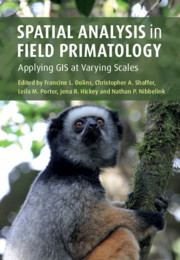Book contents
- Spatial Analysis in Field Primatology
- Spatial Analysis in Field Primatology
- Copyright page
- Dedication
- Contents
- Contributors
- Acknowledgments
- 1 Why Place Matters, and its Use in Primate Behavioral and Ecological Research
- Part I GPS for Primatologists
- Part II GIS Analysis in Fine-Scale Space
- Introduction
- 7 Home Range Analysis
- 8 Quantifying Resource Dispersion in Free-Ranging Bearded Sakis in Guyana
- 9 Interpreting Small-Scale Patterns of Ranging by Primates
- 10 Determining the Presence of Habitual Travel Route Networks in Orangutans (Pongo pygmaeus morio) in Kutai National Park, Borneo
- 11 Finding Fruit in a Tropical Rainforest
- 12 Random Walk Analyses in Primates
- 13 The Use of Small-Scale Spatial Analysis to Evaluate Primate Behavior and Welfare in Captive Settings
- 14 The Promise of Spatially Explicit Agent-Based Models for Primatology Research
- Part III GIS Analysis in Broad-Scale Space
- Index
- Plate Section (PDF Only)
- References
9 - Interpreting Small-Scale Patterns of Ranging by Primates
What Does It Mean, and Why Does It Matter?
from Part II - GIS Analysis in Fine-Scale Space
Published online by Cambridge University Press: 29 January 2021
- Spatial Analysis in Field Primatology
- Spatial Analysis in Field Primatology
- Copyright page
- Dedication
- Contents
- Contributors
- Acknowledgments
- 1 Why Place Matters, and its Use in Primate Behavioral and Ecological Research
- Part I GPS for Primatologists
- Part II GIS Analysis in Fine-Scale Space
- Introduction
- 7 Home Range Analysis
- 8 Quantifying Resource Dispersion in Free-Ranging Bearded Sakis in Guyana
- 9 Interpreting Small-Scale Patterns of Ranging by Primates
- 10 Determining the Presence of Habitual Travel Route Networks in Orangutans (Pongo pygmaeus morio) in Kutai National Park, Borneo
- 11 Finding Fruit in a Tropical Rainforest
- 12 Random Walk Analyses in Primates
- 13 The Use of Small-Scale Spatial Analysis to Evaluate Primate Behavior and Welfare in Captive Settings
- 14 The Promise of Spatially Explicit Agent-Based Models for Primatology Research
- Part III GIS Analysis in Broad-Scale Space
- Index
- Plate Section (PDF Only)
- References
Summary
Advances in technologies like GPS units, GPS collars, and GIS software have surged ahead in recent decades, allowing primatologists to quantify many aspects of their study subjects’ spatial ecology with increasing ease and accuracy. We have come a long way from the times when pioneering field primatologists would do things like measuring daily path lengths by contorting a piece of string along an animal track hand-drawn on a scale map of their trail system. However, at the same time as welcoming these advances, it is important for primatologists to continue working on the related issue of interpretation. Science, after all, is more than technology, and once the coolness factor wears off we need to ask ourselves what all those data are telling us at the end of the day.
- Type
- Chapter
- Information
- Spatial Analysis in Field PrimatologyApplying GIS at Varying Scales, pp. 180 - 203Publisher: Cambridge University PressPrint publication year: 2021
References
- 2
- Cited by



